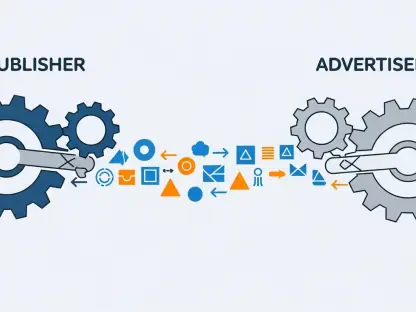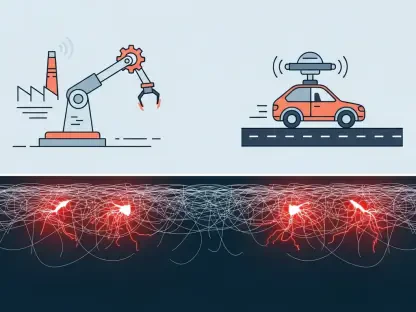Unveiling a Digital Revolution in Newport, Oregon
In a striking testament to the urgency of bridging the digital divide, a small coastal city in Oregon has become a focal point for broadband innovation. Newport, with its population of just over 10,000, now hosts its first fiber optic network, a $4.6 million endeavor by Astound that stretches across 55 miles to connect 5,000 homes and 900 businesses. This milestone is not just a local victory but a reflection of a broader national push to transform internet access in underserved areas. The market for fiber infrastructure is heating up across the United States, driven by substantial investments and strategic partnerships. This analysis delves into the trends shaping this sector, examines key data behind recent deployments, and offers projections for what lies ahead in the race for universal connectivity.
Decoding the Fiber Market: Trends, Data, and Dynamics
Surge in Fiber Investments Signals Robust Growth
The fiber optic market is experiencing unprecedented momentum, fueled by a pressing need for high-speed internet in both rural and urban landscapes. Astound’s project in Newport exemplifies this trend, with a targeted investment of $4.6 million to overhaul connectivity for a significant portion of the community. This initiative mirrors a national pattern where billions are being funneled into broadband infrastructure. Across the country, over 30,000 locations are currently benefiting from new fiber deployments, backed by hundreds of millions in capital from private equity and debt financing. This financial commitment underscores a market confidence that fiber is not just a luxury but a necessity for economic and social progress.
Regional Disparities and Strategic Deployments
Diving deeper into the geographic spread, fiber projects reveal a strategic balance between urban density and rural necessity. In Stratford, Connecticut, GoNetspeed has poured $7 million into a network targeting over 12,400 locations, leveraging the area’s population density for rapid deployment and quicker returns. Contrast this with TDS Metrocom’s efforts in Butte, Montana, where a $160 million statewide plan recently connected its 1,000th customer, highlighting the slower but vital progress in less populated regions. Meanwhile, Wire 3’s $50 million rollout in Volusia County, Florida, with plans for an additional $60 million expansion, shows how urban-adjacent areas are becoming hotspots for scalable growth. These varied approaches indicate a market adapting to diverse demographic and economic realities.
Financial Backbone: Private Capital Fuels Expansion
A critical driver of this fiber boom is the influx of private capital, shaping the market’s trajectory through strategic acquisitions and refinancing. Major players like Stonepeak, with a $400 million refinancing for Astound, and Oak Hill Capital, backing both GoNetspeed and Wire 3, are pivotal in sustaining large-scale projects. Similarly, TDS benefits from a $375 million debt facility from Oaktree Capital Management, while Pavlov Media’s expansion in Illinois is supported by $235 million from Deutsche Bank. This reliance on private equity and debt highlights a market trend where financial mechanisms are as crucial as technological advancements. However, the heavy dependence on such funding also introduces risks of over-leveraging, which could impact long-term sustainability if not carefully managed.
Technological and Consumer Demand Shifts
Beyond financing, the fiber market is being reshaped by technological advancements and evolving consumer expectations. Fiber optic networks are increasingly seen as the backbone for emerging technologies like 5G and smart city applications, pushing providers to integrate cutting-edge solutions into their deployments. Consumer demand for gigabit speeds, driven by remote work, online education, and streaming services, continues to pressure the market for faster rollouts. In Newport, for instance, upgrades to existing hybrid fiber-coaxial systems in areas like South Beach are a direct response to these needs. The market must now balance speed of deployment with quality, as reliability becomes just as critical as bandwidth in retaining customer trust.
Projecting the Future: Challenges and Opportunities Ahead
Scaling Connectivity in Underserved Regions
Looking forward, the fiber market is poised for sustained growth, with rural connectivity projects expected to multiply over the next few years. From 2025 to 2027, industry projections suggest a doubling of fiber coverage in smaller communities, driven by federal incentives and public-private partnerships. Newport’s transformation could serve as a blueprint for similar coastal or remote areas, though challenges like high construction costs and maintenance in low-density regions persist. Market analysts anticipate that innovative funding models, such as community-driven initiatives or shared infrastructure costs, may emerge to address these hurdles, ensuring that profitability does not overshadow equity.
Regulatory and Competitive Pressures
Another factor shaping the future is the regulatory landscape, which could either accelerate or hinder market expansion. Potential shifts in policies around net neutrality or infrastructure subsidies might alter investment strategies for companies like Astound and TDS. Simultaneously, increasing competition among providers, especially in urban markets like Stratford and Volusia County, risks oversaturation, potentially driving down margins. The market will likely see a push toward differentiation through value-added services or bundled offerings, as providers seek to stand out in crowded regions while maintaining momentum in less contested rural zones.
Economic Impacts and Broader Implications
Economically, the ripple effects of fiber expansion are set to be profound, with projections indicating significant boosts to local economies through job creation and enhanced business capabilities. Communities with new fiber networks are expected to attract digital-first enterprises, fostering innovation hubs even in smaller towns. However, the market must grapple with ensuring affordability, as high-speed access means little if pricing excludes lower-income households. Strategic pricing models and government-backed assistance programs could become key differentiators, influencing market share and consumer adoption rates in the coming years.
Reflecting on the Fiber Frontier: Strategic Pathways Forward
Looking back, the analysis of fiber optic market trends reveals a landscape transformed by bold investments and targeted deployments, from Astound’s pioneering network in Newport to Wire 3’s expansive Florida projects. The data paints a picture of a sector buoyed by private capital, yet challenged by geographic and financial complexities. Moving forward, stakeholders need to prioritize collaborative models, advocating for policies that support rural connectivity without neglecting urban innovation. Providers must explore tiered pricing to ensure inclusivity, while local governments can play a pivotal role by facilitating permits and infrastructure sharing. These steps, if taken, promise to sustain the momentum of this digital revolution, ensuring that connectivity becomes a universal right rather than a regional privilege.









